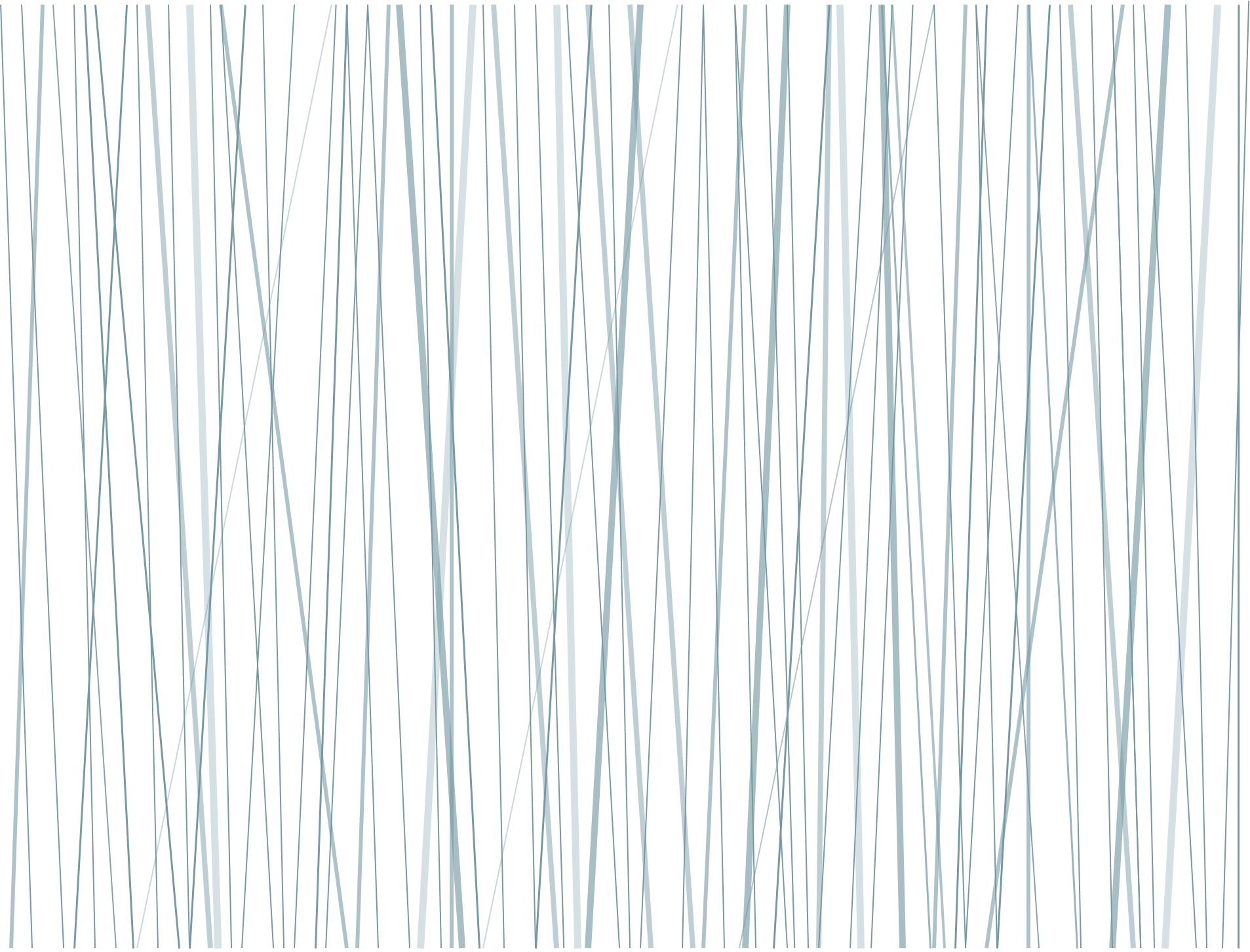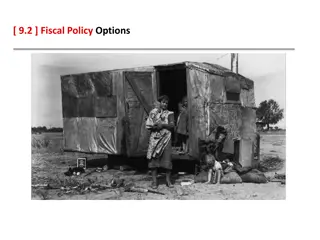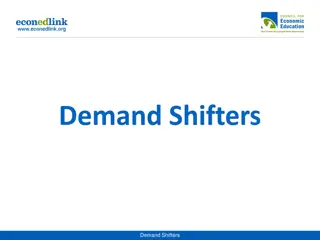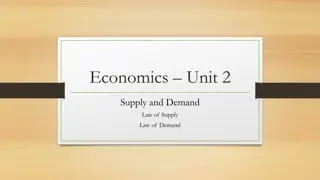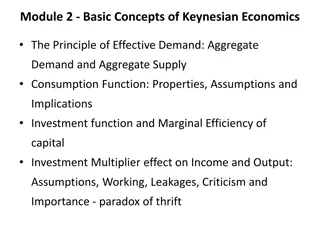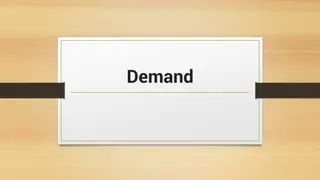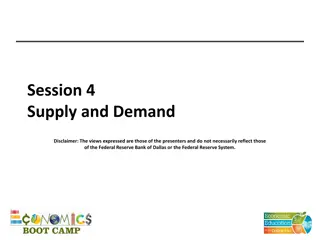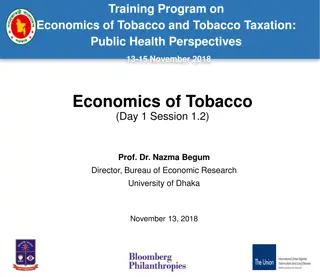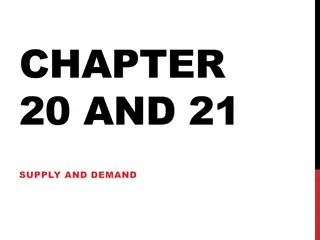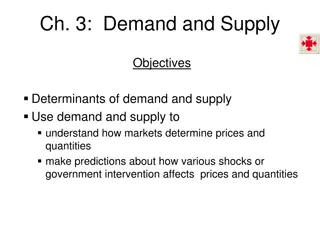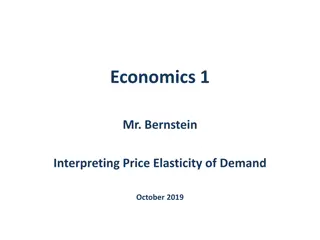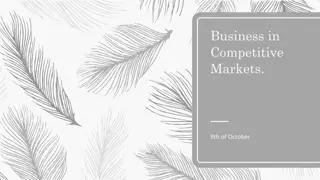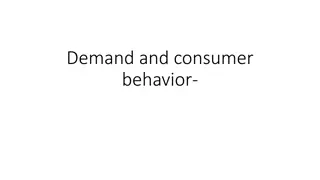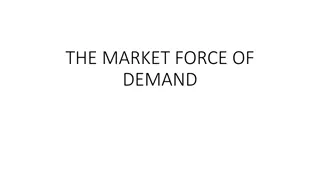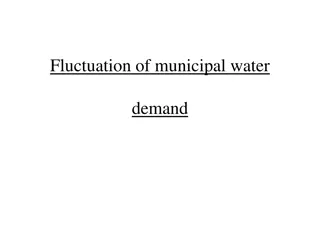Demand in Economics: Chapter 4 Overview
Demand in economics is dictated by the law of demand, where lower prices lead to increased purchases and vice versa. This chapter delves into the factors influencing demand, such as substitution effects, income effects, demand schedules, and market demand. Learn how shifts in the demand curve impact consumer behavior and determine market dynamics.
Download Presentation

Please find below an Image/Link to download the presentation.
The content on the website is provided AS IS for your information and personal use only. It may not be sold, licensed, or shared on other websites without obtaining consent from the author.If you encounter any issues during the download, it is possible that the publisher has removed the file from their server.
You are allowed to download the files provided on this website for personal or commercial use, subject to the condition that they are used lawfully. All files are the property of their respective owners.
The content on the website is provided AS IS for your information and personal use only. It may not be sold, licensed, or shared on other websites without obtaining consent from the author.
E N D
Presentation Transcript
Chapter 4 Demand
Understanding Demand Demand is the desire to own something and the ability to pay for it. The Law of demand states that when a good s price is lower, people will buy more of it. Higher prices = people buy less Example: if pizza is a dollar, people buy more. If pizza is ten dollars, people will buy less.
Understanding Demand Supply and Demand of goods determines the price and quantity produced of most goods.
Understanding Demand Substitution effects occur when people react to an increase in price by consuming less of that good and more of other goods. Example: pizza got more expensive, so I ate hot dogs instead. Pizza s price going up resulted in my buying more hot dogs.
Understanding Demand Income effect: the change in consumption resulting from a change in real income Example: John buys two donuts every morning for $1 (50 cents each). One day the price goes up to $1 each. Now John just buys one. The demand for donuts goes down. =
Understanding Demand Demand schedule is a table that lists the quantity of a good a person will buy at each different price.
Understanding Demand Market demand schedule is a table that lists the quantity of a good that all consumers in a market will buy at each different price
Understanding Demand Demand curve: a graphic representation of a demand schedule Lowest price on the bottom, highest on top. Lowest quantity on the left, highest on the right.
Chapter 4 Section 2
Shifts of the Demand Curve People buy different amounts of goods and services when price goes up or down, this is called a change in quantity demanded. Sometimes something other than prices causes demand as a whole to increase or decrease; this is called a change in demand.
Shifts of the Demand Curve Normal goods: stuff you want more of when you make more money Example: groceries, clothes, etc.
Shifts of the Demand Curve Inferior goods: stuff you buy less of when you make more money Example: top ramen, generic cereals, used cars
Shifts of the Demand Curve There are 6 factors that effect a change in demand: 1. Consumer income- if income increase, demand increases. If income decreases, demand decreases. Ex. Going out to eat 2. Consumer tastes- people buy more of a product when they are in season or advertised. (pumpkin latte at Starbucks or seasonal candy)
Shifts of the Demand Curve 3. Substitutes- goods used in place of another (ex. Generic brands) 4. Complements- two goods that are bought together and stay together. When demand of one product increases demand for the other increases as well. (Ex. When hot dogs go on sale, leads to increase in demand for hot dog buns.)
Shifts of the Demand Curve 5. Change in expectations- the way people think about the future affects what they buy. If the price is expected to rise, current demand will rise. Future price related to current demand. (ex. Gasoline)
Shifts of the Demand Curve 6. Number of customers- as population increases, people buy more products. Demand as a whole increased. Ex. Baby Boomers-Demand was raised for different goods with each age the Baby Boomers reached. They created an increased trend for goods
Shifts of the Demand Curve Increase in demand causes demand curve to shift to the right. Ex. Increase in income or population Decrease in demand causes demand curve to shift to the left. Ex. Income or population decrease.
Chapter 4 Section 3
Elasticity of Demand Elasticity of demand- a measure of how consumers react to a change in price. Elastic- describes demand that is very sensitive to a change in price. Something you buy less of if there is a small increase in price in wants such as magazines, clothes, movie tickets etc.
Elasticity of Demand Inelastic- describes demand that is not very sensitive to price. Something you will buy despite the price such as gas, medicine and houses (needs). Price increase for inelastic goods and services does not have significant impact on buying habits
Elasticity of Demand 3 questions can be asked to determine whether demand is elastic or inelastic: 1. Can the purchase be put off? A product that is needed such as medicine, must be purchased no matter the cost, making demand inelastic. If product can be put off, demand is elastic. Ex. Necessity vs Luxury= If prices are high necessities must be bought (milk) but luxuries can wait (steak)
Elasticity of Demand 2. Are enough substitutes available? If substitutes are available than buyers can choose the one that s the best price. More substitutes=elastic. The fewer substitutes=inelastic.
Elasticity of Demand 3. Does the purchase use a large portion of income? Products that require small portion of income are inelastic. When products require large part of income, demand is elastic.
Elastic or Inelastic? 1. The price of insurance goes from $70 a month to $100 a month and the quantity demanded goes from 550 to 530 a day. Elastic Inelastic 2. The price of the Carl s Jr. Western Bacon Cheeseburger has dropped from $2.00 to $1.00 and the quantity demanded has gone from 200 a day to 475 a day. Elastic Inelastic
Elastic or Inelastic? 3. The price of insulin medication goes from $75 a shot to $200 a shot and the quantity demanded goes from 450 shots a day to 425 shots a day. Elastic Inelastic 4. The price of XBOX increases from $200 to $300 and the demand drops from 1000 sold a day to 25 sold a day. Elastic Inelastic

 undefined
undefined